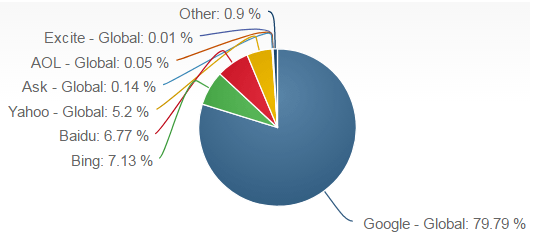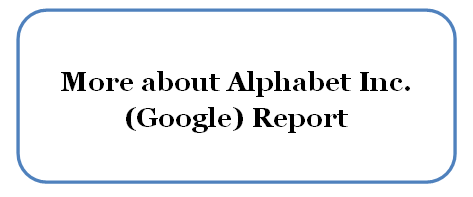Alphabet (Google) SWOT Analysis
SWOT is an acronym for strengths, weaknesses, opportunities and threats related to organizations. The following table illustrates Alphabet (Google) SWOT analysis:
| Strengths1. Market leadership in search engine segment
2. First mover advantage for many products and services 3. Organizational culture and spirit of creativity 4. Ecosystem of products and services 5. Strong position in online advertising segment
|
| Weaknesses 1. Reliance on advertising as primary source of revenues despite diversification
2. Many products and services in Alphabet portfolio are not profitable 3. High employee turnover rate at executive level 4. Sharing user information 5. Weak presence in social networking segment
|
| Opportunities 1. Increasing presence in consumer electronics industry
2. Acquisitions of related businesses 3. Increasing focus on cloud computing 4. Further developing Google+ 5. Benefiting from shift from desktop to mobile computing
|
| Threats 1. Failure of costly projects to generate profit
2. Competition from Facebook on search segment 3. Emergence of new competitors 4. Challenges of maintaining the current growth rate 5. Potential lawsuits |
Alphabet (Google) SWOT analysis
Strengths
1. Initially introduced only as a search engine, Google has effectively dominated this segment due to the speed and efficiency of operations according to the mission of the company “to organize world’s information and make it universally accessible and useful”[1]. As it is illustrated in figurebelow, Google has the market share of more than 79% in desktop search engine, whereas its closest competitor Microsoft’s Bing has the less than one fifth of Google’s market share. Google’s current leadership in search engine attracts massive revenues via advertising and this position has also positive implications on the sales of its own products and services.
Global market share distribution in desktop search segment as of April 2017[2]
2. Alphabet employs more than 27,100 people in research and development (R&D). The company invested USD 13,95 billion, USD 12,28 billion and USD 9,83 billion on R&D for 2016, 2015 and 2014 respectively.[3] Massive investments in R&D has enabled the company introduce new products for new markets in a consistent manner, thus adopting first mover advantage as a competitive advantage of the business. Specifically, the range of innovative products and services introduced by Google include, but not limited to self-driving car equipped with video cameras, radar sensors and a laser range, Google TV, a platform that integrates television and internet, Google Replay, a source for achieve of tweets, Priority Inbox feature in e-mails and others.
The first mover advantage gained by Google for above and many other products allowed the company to generate massive revenues from the sales to innovators, early adopters and early majority customer segments at the same time gaining leadership positions in respective markets.
3. Google’s organizational culture is famous for its high level of informality and effective integration of work with play. This is reflected in design of Google offices around the globe where video games, sharing cubes, pool tables, and even bowling lines are available for employees to be used at any times. Google organizational culture is developed to attract, motivate and retain the most competent workforce. Google employees also say that their job is low stress with positive implications on their performance. “While 12% of employees reporting their job isn’t stressful may not seem significant, compared to other companies on the 2015 Fortune 500 list, this is a relatively high score — only 53 companies had more employees report low stress levels at work”[4]. Google is very popular workplace target among many graduates, as well as, seasoned professionals around the world.
4. A presence of an ecosystem of Google products and services is another considerable strength of the business. The majority of Google products and services are effectively integrated with each-other forming an ecosystem that encourages the use of products and services. For example, Google runs Blogger that can be monetized with Google AdSense, the contents of the blog can be promoted via Google AdWords and content files can be stored in Google Drive. In this way, while using a specific service, customers are prompted to use additional services, with positive effects on the bottom line for the business.
5. Google maintains a leadership position in online advertising segment. According to the latest forecast by eMarketer, US digital ad spending will reach USD83.00 billion in 2017, representing an increase of 15.9%. Google will maintain its dominance and account for 40.7% of US digital ad revenues in 2017—more than double Facebook’s share.[5] Taking into account an increasing popularity of online advertising compared to traditional media advertising not only for the US, but in the global scale in general, it can be argued that leadership in online advertising is a massive strengths for Google that can be beneficial for long-term perspective.
Weaknesses
1. Despite a highly diversified portfolio of Alphabet Inc. products and services, 88% of total revenues in 2016 were generated from advertising only[6]. Google’s major strength – its leadership in online advertising can be its major weakness as well, in a way that the company manly relies on only one source of revenue. Sustainability of this revenue source is not ensured as advertisers can terminate contract at any time due to a wide range of reasons. Additionally, introduction of fundamentally innovative forms of advertising by competition can result in highly negative implications for Google in short-term and long-term perspectives.
2. Alphabet’s brand portfolio is vast and along with Google, it also includes Access, Calico, CapitalG, GV, Nest, Verily, Waymo, and X. Not all products and services within Alphabet portfolio are making profits at the moment. The majority of Alphabet’s new initiatives and projects require massive capital investments for development with no sign of profit in the foreseeable future and there is a risk that some of them may not make profit at all.
Alphabet Inc. (Google) Report contains a full version of Alphabet (Google) SWOT Analysis. The report illustrates the application of the major analytical strategic frameworks in business studies such as PESTEL, Porter’s Five Forces, Value Chain analysis and McKinsey 7S Model on Alphabet Inc. Moreover, the report contains analyses of Alphabet leadership, organizational structure, business strategy and organizational culture. The report also comprises discussions of Alphabet marketing strategy and addresses issues of corporate social responsibility.
[1] About Google (2015) Google, Available at: http://www.google.com/about/company/
[2] Desktop Search Engine Market Share (2017) Net Market Share, Available at: https://www.netmarketshare.com/search-engine-market-share.aspx?qprid=4&qpcustomd=0
[3] Annual Report (2016) Alphabet Inc.
[4] Gillett, R. (2016) “5 reasons Google is the best place to work in America and no other company can touch it” Business Insider, Available at: http://www.businessinsider.com/google-is-the-best-company-to-work-for-in-america-2016-4/#a-high-percentage-of-googlers-say-theyresatisfied-in-their-job-1
[5] Google, Facebook Increase Their Grip on Digital Ad Market (2017) eMarketer, Avaiable at: https://www.emarketer.com/Article/Google-Facebook-Increase-Their-Grip-on-Digital-Ad-Market/1015417
[6] Annual Report (2016) Alphabet Inc.


